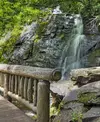If you’re an enthusiastic hiker, then you know that winter hiking can be just as fun as hiking during the warmer months! In the Smokies, trails such as Alum Cave and Andrews Bald are breathtaking when snow and ice coat the trees. We made a list of the top 10 winter hiking tips you should know before hiking in the Smoky Mountains in cold weather:
1. Look up weather and avalanche forecasts beforehand.

Winter weather can often be unpredictable, so being aware of the forecast is very important, especially if you’re planning to hike to higher elevations in the Great Smoky Mountains National Park.
2. Know your route and have reliable navigation tools.
Hiking trails can look a lot different in the winter than they do in the spring and summer, so it’s always a good idea to carry a compass and GPS in addition to trail maps, which are easy to obtain at Sugarlands Visitor Center. In fact, we have several free Smoky Mountain hiking trail maps that you can download!
3. Prepare a hiking safety plan.
Another crucial winter hiking tip is actually something you should do regardless of the time of year. A hiking safety plan can simply mean telling someone your hiking plans, such as when and where you’re going to hike, just in case something goes wrong.
4. Get good hiking gear and dress in layers.
Waterproof boots, thick wool socks, and layered clothing are a few winter hiking essentials when it comes to clothing. It may also be a good idea to buy snowshoes, microspikes, and hiking poles for added stability along snowy trails.
5. Wear sunscreen and a hat.

A couple more winter hiking tips you should know are about protecting your head and face from the cold and sun. Wearing a beanie is necessary since you can lose a lot of body heat from an uncovered head. Snow also reflects UV rays from the sun, so getting sunburned in the winter is possible!
6. Start as early in the day as possible.
Another aspect of winter hiking in the Smoky Mountains that you should consider is the time of day you begin your hike. Daylight hours are fewer during the winter months, so if you’re planning to hike a longer trail, make sure to give yourself plenty of time.
7. Avoid icy streams.
Waterfall hikes are especially beautiful when ice formations begin to form, but can become dangerous if you aren’t careful about avoiding walking on the ice. Many trails may also follow meandering streams and creeks, that could become snow-covered, so always take special precautions when it comes to icy areas of the trail.
8. Be willing to turn around.
One of the most important cold-weather hiking tips is this– don’t hesitate to turn back the way you came if a trail becomes impassable. You may also be running out of daylight or face some other obstacle, and if you’re ever in doubt if you should keep going, don’t!
9. Stay hydrated.

Take plenty of water with you on your hike, and you can even add in electrolyte tablets for an extra boost! We also recommend bringing a thermos full of your favorite hot drink or even broth to sip throughout your hike. Being dehydrated can also bring on hypothermia much quicker, which brings us to our last tip for winter hiking.
10. Be aware of the signs of hypothermia.
The final winter hiking tip we want to share is the importance of knowing the signs of hypothermia. The most common symptoms include uncontrollable shivering, slurred speech, and lethargy. If you have improper clothing, combined with the cold weather and factors of dehydration and exhaustion, it doesn’t take long for hypothermia to set in.
With these winter hiking tips, you’re now well on your way to being prepared to hike in the Smokies during the winter months! Are you interested in more cold-weather hiking content? Take a look at our complete guide to winter hiking in the Smoky Mountains.










